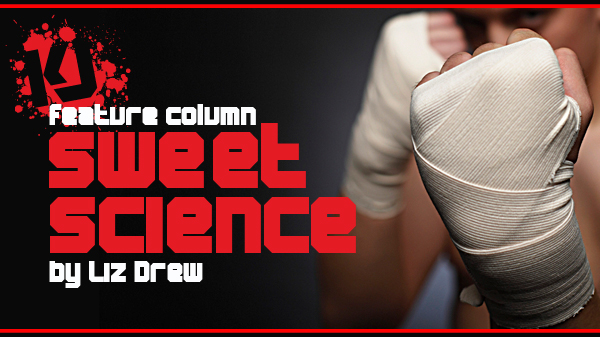My name is Liz Drew and I am the head boxing coach at Sauer MMA University in Troy, MO. My martial arts career began with the study of Shaolin Kung Fu, progressed to competition in San Da with instructor Qin rong Yu and evolved into professional boxing, which I've been practicing for 10 years with coaches Sam Gaines, Luis Camacho and now Doug Sauer. The greatest inspiration in my approach to teaching boxing comes from my study with instructor Yu, a physicist and engineer who excels at breaking down and analyzing technique.
5 Components of a Punch
There are five easily identified components of a punch. I'll use the jab as an example, as it is the fighter's first and most valuable weapon.
1. Stand against a wall and bring your hand up until it is parallel to the ground. This action shortens your bicep muscle which creates very little power.

2. Extend your arm forward and straighten it. Now you have engaged the deltoid and tricep muscles. Again not much power.

3. Step away from the wall into your fighting stance with sufficient angle. Now you have accessed your hips and legs and core. These 3 steps alone can generate a powerful punch, even going backwards.

4. Momentum – walking forward with your arm outstretched and walking into someone will move them at whatever speed you are traveling, depending on your weight ratio.

5. Gravity – falling forward with your arm outstretched into the floor will obviously create impact with the ground, if your arm didn't break.

Many fighters have achieved a powerful punch with several of these components, even if they were never analyzed. The ability to effectively coordinate all 5 parts with speed and timing is what enables explosive power. Remember that to summon maximum speed and muscle contraction, the fighter must first learn to completely ‘turn off' and relax all muscles he/she wants to call on.
Common technical flaws and their corrections:
1. Slapping with elbow out. Correction: Stand against a wall and jab until you do not feel your elbow bump the wall.
2. Punching up. Correction: Always use a mirror and punch at shoulder height. If you are fighting in the right weight class, you will be aiming at your opponents throat (if their chin isn't down) and if you are short, their solar plexus.
3. Shortening your jab. Correction: Slow down and ensure that your shoulder reaches your chin (the target) at the end of each punch.
4. Pushing instead of snapping (or lazy jab). Correction: The hand must return to your cheek at the same speed it accelerates away from your face. This protects you from a counter and creates velocity, similar to cracking a whip.

Chris Oth | Knuckle Junkies
Sweet Science
By Liz Drew | Columnist for Knuckle Junkies




Follow Knuckle Junkies